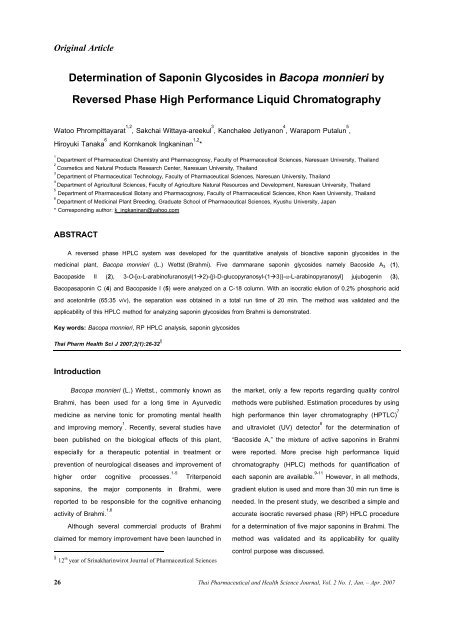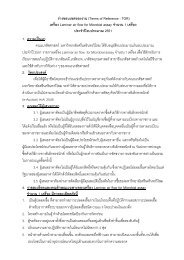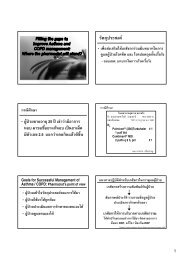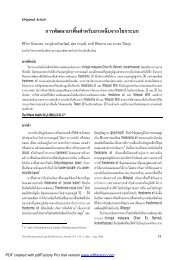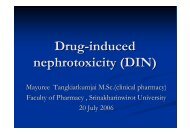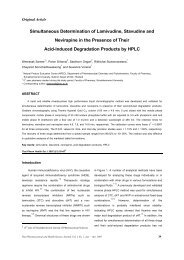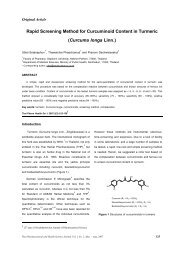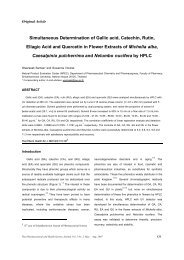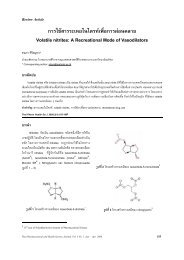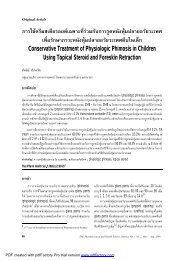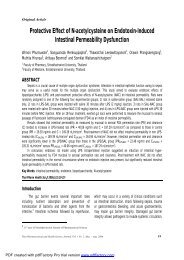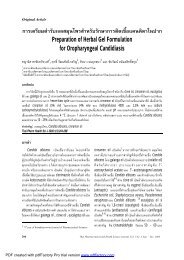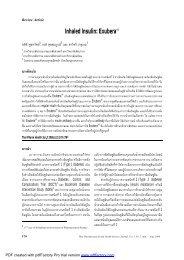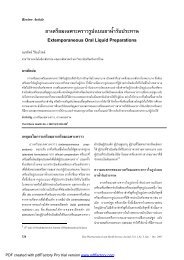Determination of Saponin Glycosides in Bacopa monnieri by ...
Determination of Saponin Glycosides in Bacopa monnieri by ...
Determination of Saponin Glycosides in Bacopa monnieri by ...
- No tags were found...
You also want an ePaper? Increase the reach of your titles
YUMPU automatically turns print PDFs into web optimized ePapers that Google loves.
Sample preparationThe dried material <strong>of</strong> Brahmi was soaked <strong>in</strong> waterfor 24 hrs and then squeezed to discard water before 4-hr percolation with 7 mL <strong>of</strong> 95% ethanol per 1 g <strong>of</strong> driedplant for 3 times. The ethanolic extract was filtrated anddried under reduced pressure. Each extract (10 mg) wasredissolved <strong>in</strong> 10 mL methanol and filtrated through a0.45 µm nylon filter prior to <strong>in</strong>jection <strong>in</strong>to thechromatographic system.HPLC AnalysisThe separation was performed us<strong>in</strong>g a ShimadzuHPLC system equipped with a SPD-M10AVP photodiodearray detector (PDA), an LC-10ATVP pump (Shimadzu,Japan) and a Rheodyne <strong>in</strong>jector with 20 µL loop. A LunaRP-18 column (150x4.6 mm, 5 µm particle size) wasused together with a Phenomenex RP-18 guard column(Torrance, CA, USA). The mobile phase consisted <strong>of</strong>0.2% phosphoric acid and acetonitrile (65:35 v/v). ThepH <strong>of</strong> the mobile phase was adjusted to 3.0 with 5 MNaOH. The flow rate and total run time were 1.0 mL/m<strong>in</strong>and 20 m<strong>in</strong>, respectively. All peaks were <strong>in</strong>tegrated atthe wavelength <strong>of</strong> 205 nm. They were <strong>in</strong>itially assigned<strong>by</strong> compar<strong>in</strong>g retention times with standards, andconfirmed with characteristic spectra obta<strong>in</strong>ed from thePDA.Method validationThe HPLC method was validated for l<strong>in</strong>earity, limit <strong>of</strong>detection (LOD), precision and accuracy. Brahmi Aextract was used as a sample for the method validation.The l<strong>in</strong>earity <strong>of</strong> the method was evaluated <strong>in</strong> the 7.8 to500.0 µg/mL range. Seven concentrations <strong>of</strong> fivestandard sapon<strong>in</strong>s were chosen for generat<strong>in</strong>g thecalibration curves. Three determ<strong>in</strong>ations (n = 3) werecarried out for each solution. The correlation graphs wereconstructed <strong>by</strong> plott<strong>in</strong>g the obta<strong>in</strong>ed peak areas versusthe <strong>in</strong>jected concentrations. The LOD was determ<strong>in</strong>ed <strong>by</strong>a serial dilution <strong>of</strong> the mixture <strong>of</strong> five standards. Theconcentration that gave a signal to noise ratio <strong>of</strong> 3 wasregarded as m<strong>in</strong>imal detectable amount recorded. Forspecificity test, peak purity was confirmed <strong>by</strong> study<strong>in</strong>gthe PDA data <strong>of</strong> all relevant peaks. Intra- and <strong>in</strong>ter-dayprecisions were determ<strong>in</strong>ed <strong>by</strong> the analysis <strong>of</strong> twoconcentrations (2 and 5 mg/mL) for each analyte andexpressed as percentage <strong>of</strong> relative standard deviation(% RSD). In the <strong>in</strong>tra-day precision experiment, fivedeterm<strong>in</strong>ations (n = 5) were carried out for eachconcentration for any given day. The <strong>in</strong>ter-day precisionwas measured <strong>in</strong> triplicate (n = 3) for three consecutivedays. The accuracy <strong>of</strong> the method was evaluated <strong>by</strong>analyz<strong>in</strong>g the mixture that prepared <strong>by</strong> add<strong>in</strong>g 20 µg/mL<strong>of</strong> standard sapon<strong>in</strong>s to the Brahmi extract, conta<strong>in</strong><strong>in</strong>g aknown amount <strong>of</strong> the analyzed sapon<strong>in</strong>s. Threedeterm<strong>in</strong>ations (n = 3) were carried out.Results and DiscussionsIn order to optimize the HPLC system fordeterm<strong>in</strong>ation <strong>of</strong> five sapon<strong>in</strong> glycosides (1 - 5) <strong>in</strong>Brahmi, we various column systems were tested. These<strong>in</strong>cluded column types (normal phase and reversedphase columns), lengths (150 - 250 mm), particle sizes(3 – 5 µm) and sources (Phenomenex, Altech, Water).Various mobile phases were also used. F<strong>in</strong>ally, theexperiments showed that a Luna RP 18 (Phenomenex,CA, USA) with an isocratic elution <strong>of</strong> 0.2% phosphoricacid and acetonitrile (65:35 v/v; pH 3.0) gave the bestseparation <strong>in</strong> the shortest time.The chromatograms <strong>of</strong> the mixture <strong>of</strong> five sapon<strong>in</strong>reference standards and Brahmi extract are presented <strong>in</strong>Figure 2. Due to their poor chromophores, most <strong>of</strong> theBrahmi triterpenoid sapon<strong>in</strong>s can only be detected atwavelength <strong>of</strong> 205 nm. The retention time <strong>of</strong> compound 4slightly shifted. The identification <strong>of</strong> the peak wasconfirmed <strong>by</strong> add<strong>in</strong>g the standard compound to theextract. All sapon<strong>in</strong>s gave LOD with<strong>in</strong> a range <strong>of</strong> 0.3 -0.6 µg/mL (Table 1).Analytical data <strong>of</strong> each reference standard at sevenconcentrations were obta<strong>in</strong>ed from at least threeexperiments. Calibration curves were generated <strong>by</strong> l<strong>in</strong>earregression based on the peak areas. The l<strong>in</strong>earity wasobta<strong>in</strong>ed with<strong>in</strong> the range <strong>of</strong> <strong>in</strong>jected concentrations (7.828 Thai Pharmaceutical and Health Science Journal, Vol. 2 No. 1, Jan. – Apr. 2007
which was <strong>in</strong> the acceptable range (85-115%) accord<strong>in</strong>gto general analytical guidel<strong>in</strong>e 12-14 . This <strong>in</strong>dicated that thisRP HPLC method had adequate accuracy. Moreover,compared with the HPLC methods developed <strong>by</strong>Ganzera et al. 10 and Deepak et al. 11 which all weregradient elution systems, our method is more practicaland simple. Isocratic elution was used allow<strong>in</strong>g therecirculation <strong>of</strong> the mobile phase which can save cost <strong>of</strong>the analysis. Also a shorter run time (20 m<strong>in</strong>) wasobta<strong>in</strong>ed.Table 2 Intra- and <strong>in</strong>ter-day precision <strong>of</strong> the <strong>in</strong>vestigatedsapon<strong>in</strong>s under optimized RP HPLC conditionsAnalyte Conc.(mg/mL)% Intra-day RSD(n = 5)% Inter-day RSD(n = 3)1 2.0 3.22 5.125.0 1.17 7.112 2.0 0.28 2.205.0 0.74 1.693 2.0 2.12 9.895.0 1.58 9.394 2.0 1.04 5.705.0 1.83 4.295 2.0 2.82 3.455.0 0.59 3.20Table 3 Recoveries <strong>of</strong> the <strong>in</strong>vestigated sapon<strong>in</strong>s fromBrahmi shoot extract <strong>by</strong> us<strong>in</strong>g RP HPLCAnalyte% Recovery (%RSD)1 92.24 (5.94)2 85.75 (8.56)3 93.84 (9.12)4 90.92 (4.87)5 103.05 (5.11)Note: Values are shown as mean percentage <strong>of</strong> recovery from threeexperiments.Aerial parts <strong>of</strong> Brahmi collected from three places <strong>in</strong>Thailand were analyzed. A typical HPLC chromatogram<strong>of</strong> the extract is shown <strong>in</strong> Figure 2B. All samples gavethe similar HPLC f<strong>in</strong>gerpr<strong>in</strong>ts. Five major sapon<strong>in</strong>s weredetected and quantified (Tables 4). The dom<strong>in</strong>antcompound was either <strong>Bacopa</strong>side II (2; 0.27-0.59%) or<strong>Bacopa</strong>side I (5, 0.35-0.71%). The total amounts <strong>of</strong>sapon<strong>in</strong>s <strong>in</strong> the samples were varied from 1.11 to 2.16%.It is noted that the presence <strong>of</strong> <strong>Bacopa</strong>side I (5) <strong>in</strong> theHPLC analyses <strong>of</strong> Brahmi have not been mentioned <strong>in</strong>the reports <strong>of</strong> Ganzera et al. 10 and Deepak et al. 11 .However, Ganzera et al. also found an unidentified peak<strong>of</strong> sapon<strong>in</strong> <strong>in</strong> their chromatogram with the same pattern<strong>of</strong> the peak which was identified as <strong>Bacopa</strong>side I <strong>in</strong> ouranalysis.Bacoside A is known as marker for standardization<strong>of</strong> the commercial product <strong>of</strong> Brahmi. However, it hasjust been recently reported as a mixture <strong>of</strong> four sapon<strong>in</strong>s<strong>by</strong> Deepak et al. 14 . The composition <strong>of</strong> Bacoside A wasconfirmed to consist <strong>of</strong> compounds 1-4 (Table 4).Compound 3, the jujubogen<strong>in</strong> isomer <strong>of</strong> bacopasapon<strong>in</strong>C, was present <strong>in</strong> the highest concentration which was <strong>in</strong>agreement with the previous study.In the general harvest<strong>in</strong>g procedure <strong>of</strong> Brahmi, onlythe shoots are collected. The other parts are spared topromote the further growth <strong>of</strong> this plant. In order toconfirm that the quantity <strong>of</strong> sapon<strong>in</strong>s <strong>in</strong> the shoots washigher than other parts, the amounts <strong>of</strong> sapon<strong>in</strong>s <strong>in</strong> thedifferent parts were also analyzed (Table 5). The highestsapon<strong>in</strong> content (2.03%) was obta<strong>in</strong>ed from the shootswhereas the roots conta<strong>in</strong>ed around four times lesssapon<strong>in</strong>s (0.51%).In conclusion, the present study describes an RPHPLC method as a practical method for the quantification<strong>of</strong> triterpenoid sapon<strong>in</strong>s <strong>in</strong> the medic<strong>in</strong>al plant, Brahmi. Atoptimized conditions, a separation <strong>of</strong> five sapon<strong>in</strong>s wasfeasible with<strong>in</strong> 20 m<strong>in</strong>. Furthermore, the method wasvalidated for l<strong>in</strong>earity, limit <strong>of</strong> detection, accuracy,precision, and <strong>in</strong>tra- and <strong>in</strong>ter-day variations.AcknowledgementsThe grant from National Research Council <strong>of</strong>Thailand is gratefully acknowledged. The authors thankNaresuan University for a Ph.D. scholarship <strong>of</strong> the firstauthor. Special thanks to Ms. Dusadee Pongpeaw(Health & Herb Intergroup, Thailand) for provid<strong>in</strong>g the30 Thai Pharmaceutical and Health Science Journal, Vol. 2 No. 1, Jan. – Apr. 2007
harvested <strong>Bacopa</strong> monniera shoots revealed us<strong>in</strong>g ahigh performance th<strong>in</strong> layer chromatography method. JMed Arom Plant Sci 1998;20:1052-1055.8. Pal R, Sar<strong>in</strong> JPS. Quantitative determ<strong>in</strong>ation <strong>of</strong> bacosides<strong>by</strong> UV-spectrophotometry. Ind J Pharmaceut Sci 1992;53:711-714.9. Renukappa T, Roos G, Klaiber I, Volger B, Kraus W.Application <strong>of</strong> high-performance liquid chromatographycoupled to nuclear magnetic resonance spectrometry,mass spectrometry and bioassay for the determ<strong>in</strong>ation <strong>of</strong>active sapon<strong>in</strong>s from <strong>Bacopa</strong> monniera Wettst. JChromatogr A 1999;847:109-116.10. Ganzera M, Gampenrieder J, Pawar RS, Khan IA,Stuppner H. Separation <strong>of</strong> the major triterpenoidsapon<strong>in</strong>s <strong>in</strong> <strong>Bacopa</strong> monniera <strong>by</strong> high-performance liquidchromatography. Anal Chim Acta 2004;516:149-154.11. Deepak M, Sanggli GK, Arun PC, Amit A. Quantitativedeterm<strong>in</strong>ation <strong>of</strong> the major sapon<strong>in</strong> mixture Bacoside A<strong>in</strong> <strong>Bacopa</strong> <strong>monnieri</strong> <strong>by</strong> HPLC. Phytochem Anal 2005;16:24-29.12. Ermer J, Miller JHMcB. Method validation <strong>in</strong>pharmaceutical analysis: a guide to best practice. NewYork. John Wiley & Sons Inc, 2005.13. Chan CC, Lee YC, Lam H, Zhang XM. Analytical methodvalidation and <strong>in</strong>strument performance verification. NewJersey. John Wiley & Sons Inc, 2004.14. Miller JM, Crowther JB, Miller J. Analytical chemistry <strong>in</strong> aGMP environment: a practical guide. New York. JohnWiley & Sons Inc, 2000.32 Thai Pharmaceutical and Health Science Journal, Vol. 2 No. 1, Jan. – Apr. 2007


